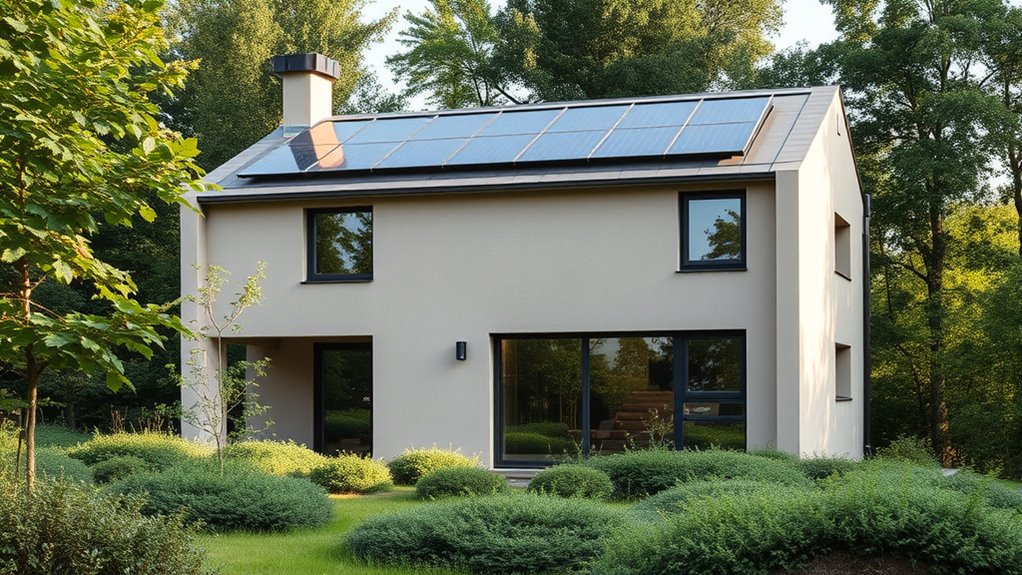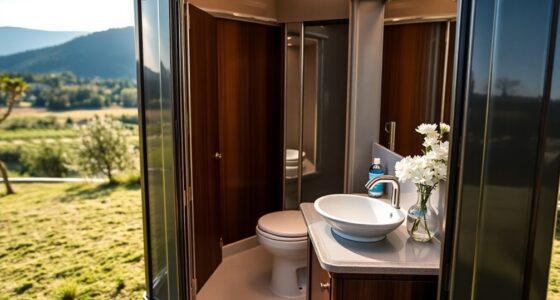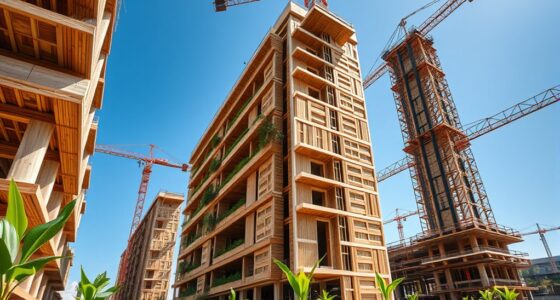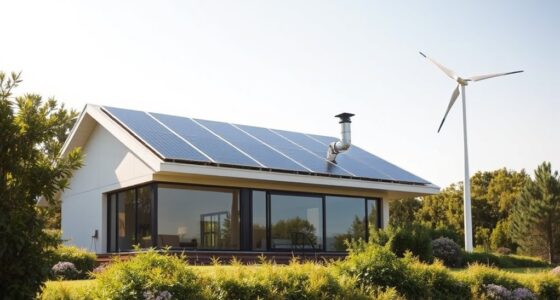Passive house design creates ultra-efficient homes by focusing on top-tier insulation, airtight construction, and smart ventilation. It minimizes energy needs for heating and cooling, making your home stable and comfortable year-round. You’ll benefit from reduced energy bills and a smaller carbon footprint while enjoying a consistent indoor climate. If you want to understand how these clever principles work together to maximize efficiency and comfort, there’s plenty more to explore.
Key Takeaways
- Passive House design creates highly energy-efficient homes by minimizing heating and cooling needs through superior insulation and airtight construction.
- Thermal insulation acts as a barrier to heat transfer, maintaining stable indoor temperatures year-round.
- Airtight building envelopes prevent air leaks, reducing drafts and conserving conditioned air efficiently.
- Combining airtightness with high-performance windows and controlled ventilation systems optimizes indoor air quality and energy savings.
- Overall, Passive House design lowers energy consumption, enhances comfort, and promotes sustainable, resilient building practices.

Have you ever wondered how some buildings stay comfortable year-round while using very little energy? The secret often lies in passive house design, which focuses on creating ultra-efficient homes that require minimal heating and cooling. At the heart of this approach are two essential elements: thermal insulation and airtight construction. These components work together to dramatically reduce energy loss, ensuring your home stays warm in winter and cool in summer without relying heavily on traditional HVAC systems.
Thermal insulation is vital because it acts as a barrier, slowing down heat transfer between the interior of your home and the outside environment. When properly installed, insulation materials—such as high-performance foam or mineral wool—trap the internal heat during winter and prevent unwanted heat from entering during summer. This means your home maintains a stable indoor temperature, reducing the need for active heating or cooling. But insulation alone isn’t enough. You also need airtight construction, which involves sealing all gaps, cracks, and leaks in your building envelope. Think of it as wrapping your entire home in a tight, protective shell that keeps conditioned air inside and unconditioned air outside. This airtightness prevents drafts and minimizes heat loss or gain through air leakage, which can considerably undermine comfort and energy efficiency.
When you combine thermal insulation with airtight construction, you create a highly controlled environment. The building envelope becomes a barrier against external temperature fluctuations, allowing your home to stay comfortable with minimal energy input. This synergy also enhances the effectiveness of ventilation systems, which are designed to bring in fresh air while recovering heat from exhaust air. This controlled ventilation ensures good indoor air quality without sacrificing energy savings. Additionally, integrating high-performance windows further reduces heat transfer, maximizing overall efficiency. Proper installation techniques are essential to ensure that all sealing and insulation methods perform as intended over time, preventing future energy losses. Incorporating airtightness testing during and after construction can help identify and address potential leaks, ensuring standards are met.
Achieving airtight construction requires meticulous detailing and quality workmanship. Every joint, seam, and penetration must be properly sealed using specialized tapes, gaskets, or sealants. It may seem like a lot of effort upfront, but it pays off in long-term energy savings and increased comfort. Proper building envelope design is crucial to prevent air leaks and ensure the passive house standards are met. Plus, modern passive house designs often incorporate high-performance windows and doors that complement the thermal insulation and airtight shell, further reducing heat transfer.
In essence, passive house design is about creating a resilient, energy-efficient home that minimizes reliance on traditional energy sources. By prioritizing thermal insulation and airtight construction, you’re not only reducing your carbon footprint but also enjoying a more comfortable, predictable indoor environment year-round. It’s a smart, sustainable choice for anyone looking to build or retrofit a home that performs at the highest level of efficiency.
Frequently Asked Questions
What Is the Typical Cost Difference for Passive House Construction?
When considering the cost comparison for passive house construction, you’ll find it typically costs 5-15% more upfront than standard homes. However, your budget considerations should include long-term savings on energy bills and increased comfort. While initial costs are higher, the energy efficiency pays off over time. You should weigh these factors carefully to determine if the higher upfront investment aligns with your financial goals.
How Long Does It Take to Design a Passive House?
The design process for a passive house typically takes around 6 to 12 months, depending on your project’s complexity. Your planning timeline includes detailed assessments, energy modeling, and coordination with specialists. You actively participate in decision-making, ensuring efficiency goals are met. This structured planning helps streamline the process, but it is crucial to allocate enough time upfront to address all design considerations and achieve your ultra-efficient home.
Are Passive Houses Suitable for All Climates Globally?
You wonder if passive houses suit all climates. While they excel in cold and temperate zones due to their climate adaptability, they may need adjustments in hot, humid, or extreme environments. Regional feasibility depends on local climate, building codes, and available materials. You can design a passive house tailored to your area’s conditions, but it’s essential to work with experts who understand regional challenges to maximize energy efficiency and comfort.
What Maintenance Is Required for Passive House Systems?
You’ll need to perform regular HVAC upkeep to guarantee your passive house’s ventilation system functions efficiently. Insulation checks are also essential, as they help maintain ideal energy performance and prevent drafts. Additionally, inspect seals around windows and doors periodically to avoid heat loss. These simple maintenance tasks help keep your home comfortable, energy-efficient, and in top condition, ensuring you enjoy the benefits of a passive house for years to come.
Can Existing Homes Be Retrofitted to Meet Passive House Standards?
You can retrofit existing homes to meet passive house standards, but you’ll face some challenges. Retrofitting involves upgrading insulation, sealing leaks, and installing high-efficiency windows, which can be costly and complex. The main retrofitting challenges include limited space for upgrades and potential structural modifications. While the cost implications are significant, the long-term energy savings and comfort improvements make it a worthwhile investment if you’re committed to sustainability.
Conclusion
Imagine your home as a warm, energy-saving fortress that hugs you tightly, no matter the weather outside. Passive house design makes this possible by creating a barrier against the elements while letting in just enough sunlight. It’s like building a cozy cocoon that conserves energy effortlessly. Embracing this approach means you’ll enjoy lower bills and a greener footprint, all while living comfortably. It’s not just a house; it’s a smart, sustainable sanctuary for the future.










